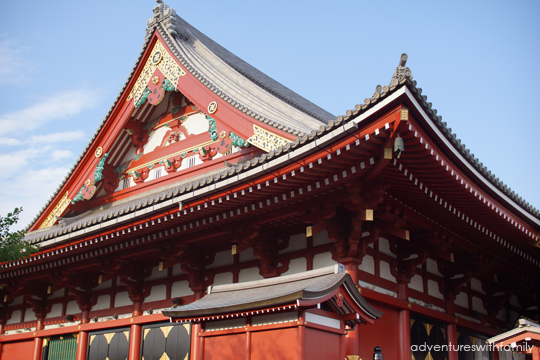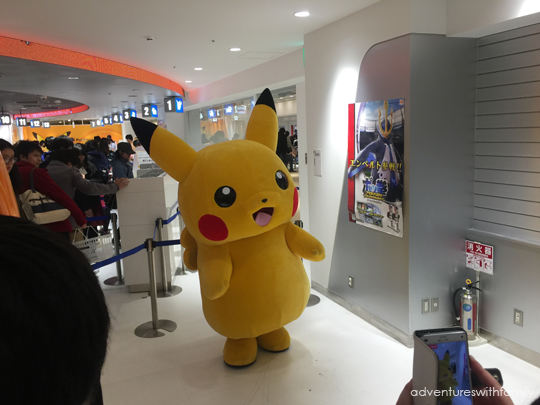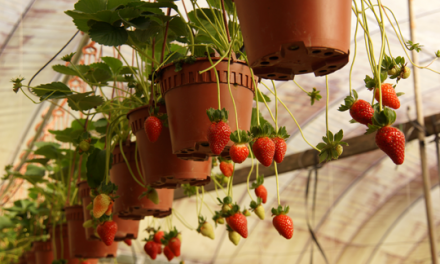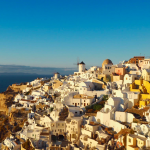Tokyo is a city that needs little introduction. As part of our 10-day free-and-easy Japan trip, we spent half of the time in Tokyo with two days at Disney parks, two days exploring the famous city and one day side trip from Tokyo to Mt Fuji.
The first thing we realised when we were in Tokyo was how big the city was. Getting from one area of the city to another can take more than half an hour, so it is a good idea to plan the itinerary according to the different “zones” as defined by Tokyo Metro. The zones from east to west are listed below:
- Cultural Fusion – This area includes Tsukiji Fish Market, Kabuki Theatre, Akihabara (for electronics), Sumo Hall, Ueno (Park, Zoo and Ameyoko Shopping Street), Asakusa (temple and shopping) and Tokyo Skytree.
- Metropolitan Luxury – This area includes luxury shopping near Tokyo station, at Ginza, and Marunouchi. The Imperial Palace is also within this “zone”.
- Night Life – Roppongi Hills, Tokyo Tower, and Tokyo Midtown.
- Cool Tokyo – This area centers around the latest fashion, with plenty of eateries. It includes Shinjuku, Shibuya, Harajuku and Takeshita Steet.
We went to the Cultural Fusion zone on our first full day, Disney theme parks on Day 2 and 3, and the Cool Tokyo zone on the fourth day. On our second trip to Tokyo, we explored other parts of Cool Tokyo zone again.
DAY 1 – TOKYO’S CULTURAL FUSION
The two most interesting places to visit in Tokyo were the Tsukiji Fish Market and Asakusa. These two attractions can be covered in one day.
Tsukiji Fish Market
Tsukiji Fish Market is the world’s biggest seafood and fish wholesale market. Those willing to wake up early to be the first 50 in the queue can observe the tuna auction that happens before dawn.
We arrived at Tsukiji Fish Market at around 10am and the market was bustling with people. Many restaurants were packed with people trying out the freshest selection of sashimi over a bowl of rice. Some were open until late evening. One of the most popular restaurants around Tsukiji Fish Market was Sushi Zanmai. People were willing to wait in line to sample its seafood.
Tip: If you are planning to visit the Tsukiji Fish Market, look around for another branch just one street away. This branch had a much shorter queue.


Apart from seafood, the Tsukiji Fish Market was a great place to buy good Japanese knifes and other Japanese kitchenware. It also has the nicest almonds. Our family is not exactly fond of almonds, but the ones we bought there were so tasty that we couldn’t stop eating them. You have got to try the almonds when visiting the Tsukiji Fish Market.
Sadly, there are plans to close down the Tsukiji Fish Market next year and relocate it to Toyosu to free up the prime seaside real estate.
Getting there: There are three train stations near Tsukiji Fish Market. Tsukiji Shijo station on the Oedo subway line is the nearest, while the Tsukiji Station on the Hibiya line is 5 minutes away. If you have a JR pass, you need not pay more if you take the train to Shimbashi JR station and walk 15 minutes to the market.
Asakusa
One thing that makes Tokyo special is that it blends the old and the new perfectly. Despite the modernisation and technological advancements, the city still preserves its rich history and culture. The best place to experience the latter is in Asakusa, home to one of the most popular Buddhist temples in Tokyo called Senso-ji.
You will know when you have reached the entrance of the historic town when you see the Kaminarimon (thunder gate), the symbol of Asakusa with its large red paper lantern.

Between the gate and the temple lies Nakamisme-dori, one of the oldest shopping streets in Tokyo offering various types of local snacks, fresh soft creams (ice creams) and a wide selection of unique Japanese souvenirs.

From bags and purses with pretty Japanese prints to Yukatas and Ninja clothing and footwear, it is no surprise that the line of shops attract many visitors. The nice thing about walking around the historic town is that you can find a number of ladies dressed in pretty kimonos.

One thing unique about Japan was ordering food at a dine-in through a vending machine. One place to try that was Naritaya which was less than 5 minutes away from the Senso-ji temple. Naritaya served delicious halal ramen. Read more about our food adventures in Tokyo.
The freshly-baked Japanese buns at a shop right across from Naritaya was also worth trying.
DAY 2 & 3 – TOKYO DISNEYLAND AND DISNEY SEA
We spent a full day at Tokyo DisneySea and another at Tokyo Disneyland. Read more about our visit to Tokyo Disneyland and DisneySea.
DAY 4 – COOL TOKYO
On our fourth day, we spent our time exploring Shinjuku and Shibuya – two popular places in Tokyo for the shopping, dining and entertainment.
Shinjuku
Shinjuku is home to Tokyo’s tallest skyscrapers, and department stores selling Japan’s latest fashion. We were fascinated by Shinjuku’s train station. It is the busiest train station in the world and yet amazingly reliable. All the trains we took arrived on schedule. Despite handling 2 million commuters per day, everyone was extremely orderly and polite moving up the escalator and getting from one platform to another.
Godzilla in Tokyo

Who says Japan doesn’t have Godzilla? You can spot Godzilla at Hotel Gracery Shinjuku located within the Kabukicho area of Shinjuku. We stayed one night at this hotel because it was conveniently located within 5 minutes from Shinjuku JR station. We got the best rates on Booking.com (Hotel Gracery Shinjuku).
Shibuya Mad Crossing
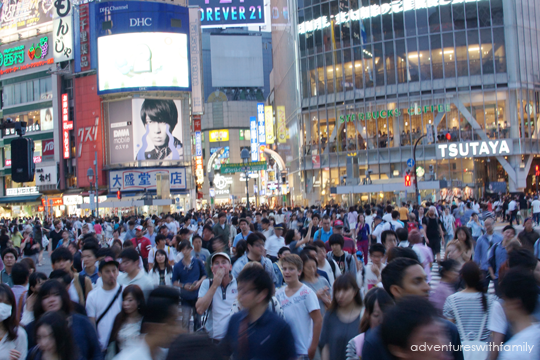
Shibuya is a colourful and busy district in Tokyo with lots of shopping centres and eateries. It is one train stop away from Shinjuku on the JR Yamanote line. Like most other visitors, we crossed the famous Shibuya crossing, a large intersection that allows pedestrian from all directions to cross the road at the same time and in all directions. The pedestrian mad scramble, as some called it, might seem chaotic, but everyone moved about in an orderly fashion. You need to exit at Hachiko exit of Shibuya station to get to the famous Shibuya crossing. One of the popular department stores in Shibuya is the Shibuya Hikarie. We also had a satisfying Yakiniku BBQ dinner at Gyumon. Read more about our food adventures in Tokyo.
DAY 5 – TOKYO SHOPPING
Day 5 is all about visiting some of Tokyo’s most famous shopping areas.
Pokemon Centre Mega Tokyo Store
We visited Pokemon Centre Mega Tokyo Store where the kids picked up some Pokemon stuff toys that were not available elsewhere.
Another place that is great for shopping in Tokyo is at Tokyu Hands. It had floors of things that were just so uniquely Japanese that we could not resist buying a number of small things there.
DAY 6 – COOL TOKYO
Harajuku
We visited Harajuku which is the source of latest fashion in Japan. Harajuku is also a unique place in Tokyo where you can find lots of youngsters dressed in cosplay (costume playing).
While in Harajuku, you have to try the crepes from Marion Crepes and the incredibly huge cotton candy from Totti Candy Factory. The cotton candy was so popular that we had to take a queue number and come back in 30 minutes.
Akihabara
Our next stop was Akihabara, a haven for everything electronics. Yodobashi-Akiba had floors of electronic products and gadgets. Imagine one huge section for just PS VITA, another huge section just for earphones, and another huge section just for blank discs.
Sushi in Asakusa
In the evening, we went to Asakusa to have dinner at Asakusa Sushi-ken.
We also did some shopping at Don Quijote, the biggest discount chain store with a wide range of products packed to the brim over multiple floors.
Day trip to Mt Fuji

Mt Fuji is arguably one of the most famous attractions in Japan. As we had purchased the Japan Rail pass, we took the JR train from Shinjuku station. The ride from Shinjuku to Otsuki was covered by the JR pass, whereas the part from Otsuki to Kawaguchiko was not. We had to pay for that segment when we exited at Kawaguchiko station. Altogether, it took us about 2 hours to get to Kawaguchiko station.
 We knew the visibility would not be great in the warmer months, but we took our chance and headed to the north shore which was supposed to be the best place to see Mt Fuji with the lake in front of it. To get to the north shore, we took the Red Line sightseeing bus just outside the train station and alighted at the last stop.
We knew the visibility would not be great in the warmer months, but we took our chance and headed to the north shore which was supposed to be the best place to see Mt Fuji with the lake in front of it. To get to the north shore, we took the Red Line sightseeing bus just outside the train station and alighted at the last stop.
True enough the visibility was not great, but we made the best of things and had soft creams while enjoying the fresh air in front of Lake Kawaguchiko. It was the best soft cream we tried during our trip to Japan.
After the refreshing dessert, we headed to the Lake Kawaguchiko resort area (bus stop 10), had lunch and explored the lava rocks there.

The Tatamiiwa lava rocks pictured above was formed by the lava flow from Mt Fuji’s eruption 10 centuries ago.
There was also a ropeway (cable car) nearby that would have provided a fantastic view of Mt Fuji on a clear day.
Tips
- You can buy Tokyo attraction tickets, Disney park tickets as well as Tokyo tours from Voyagin.com.
- Getting around – the best and most economical way to get around Tokyo city is via the Tokyo subway. There are three types of train lines in Tokyo (1) Metro Line (2) Toei Line and (3) JR Line. If you have the JR pass, you can only use it on the JR lines. There are three types of Day passes – (1) Metro pass at 600 yen, (2) Metro and Toei pass at 1,000 yen and (3) All 3 lines at 1,590 yen. As the prices vary quite significantly, it would be good if you could decide your route and choose the most cost-effective day pass.
- Train Interchanges – We did not do our homework and bought the cheapest day pass for the Tokyo Metro line only. We didn’t realise that we had to change trains multiple times to get to our destination by using the Metro Line only. The walk between the train lines within the same train station can be quite long (e.g. 500m), so if you had to change train 3-4 times, you would have walked for 1.5-2km. This is an important tip when you are travelling with young children or elderly, so consider the number of train changes you would have to make when you decide which day pass to buy.
- Souvenir shopping – Narita Airport was a great place to purchase Japanese snacks packed in nice souvenir gift boxes. If you didn’t have much time buying souvenirs in the city, get it at the airport. You would also save on taxes when you buy at the airport.
- Mt Fuji’s visibility – If you are planning to visit Mt Fuji while in Tokyo, you should take note that visibility is good in the colder months and pretty bad in the warmer months. The best time to see Mt Fuji is between October and February. Check the live cam at www.fujigoko.tv/english/ before going.
- Getting to Mt Fuji – If you have the JR pass, take the JR Chuo Line from Shinjuku, else take the Fujikyu highway bus.
Where to Stay in Tokyo
We stayed at a few places in Tokyo. Most of the time, we stayed at Shin-Okubo as there are a number of budget-friendly family Japanese accommodations.
We also stayed in Shinjuku once at Hotel Gracery Shinjuku.





